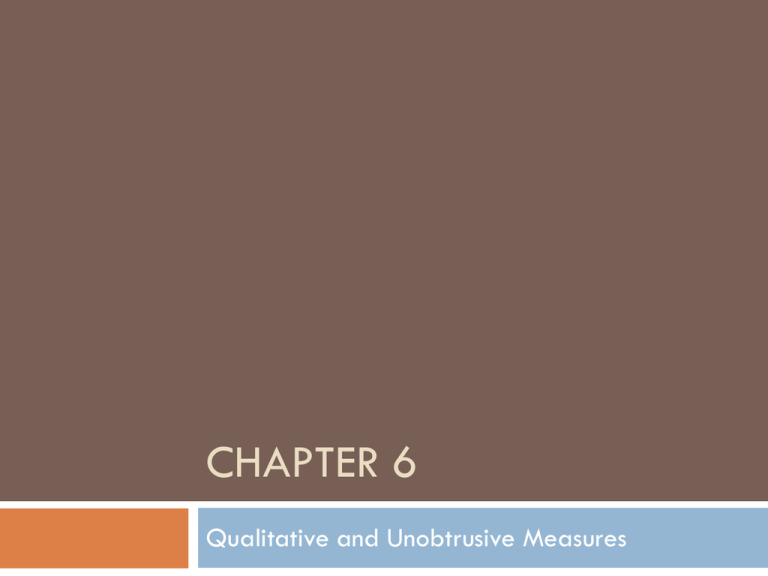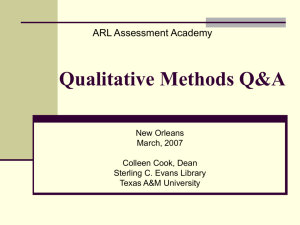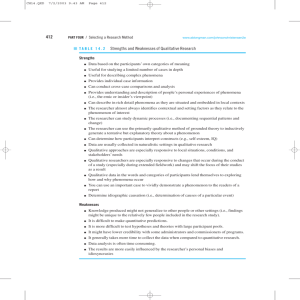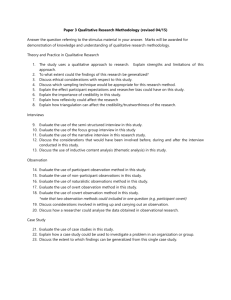Comparing Qualitative & Quantitative Methodologies
advertisement

CHAPTER 6 Qualitative and Unobtrusive Measures Qualitative Measures Qualitative research is any research that relies primarily or exclusively on qualitative measures Qualitative research (i.e., measures) used to: Generate new theories or hypotheses Achieve a deep understanding of an issue Develop detailed stories to describe a phenomenon Qualitative and Quantitative Data Qualitative data consists of “words” Quantitative data consists of “numbers” All qualitative data can be coded quantitatively All quantitative data is based on qualitative judgment Qualitative Data Includes any information that can be captured that is not numerical in nature (Miles & Huberman, 1994) In-depth interviews (individual and group) Direct observation (respondent is not queried) Written documents (existing documents) Qualitative Traditions Ethnography studying a phenomenon in the context of its culture Phenomenology studying how a phenomenon is experienced by participants Field Research researcher observes a phenomenon in its natural state (“in situ”) Grounded Theory (Glaser & Strauss, 1967) to develop a theory (“grounded” in observation) about a phenomenon of interest Qualitative Methods Participant observation Direct observation researcher not a member of the culture being studied but remains unobtrusive Unstructured interviewing researcher becomes a participant (i.e., member) in the culture being observed direct interaction between the researcher and respondent; no structured interview or set direction Case studies intensive study of a specific individual or specific context Table 6-3 Criteria for Judging Research Quality from a More Qualitative Perspective Traditional Criteria for Judging Quantitative Research Alternative Criteria for Judging Qualitative Research Internal validity Credibility External validity Transferability Reliability Dependability Objectivity Confirmability Quality of Qualitative Research Credibility Transferability degree to which results can be generalized to other contexts Dependability establishing that the results are credible from the perspective of the participant description by the researcher of changes within the context that the research occurs and how these might affect conclusions Confirmability degree to which others can confirm or corroborate the results Unobtrusive Measures Indirect Measures The researcher collects data without the participant being aware of it Attention must be paid to ethical considerations Possibility of deception Invasion of privacy No informed consent Unobtrusive Measures (cont’d) Content Analysis Systematic analysis of text in order to identify patterns Thematic analysis of text Indexing Quantitative descriptive analysis Unobtrusive Measures (cont’d) Content Analysis (cont’d) May involve sampling from the population of potential texts Identification of units of analysis Coding of units of analysis Limitations Unobtrusive Measures (cont’d) Secondary Analysis of Data Re-analysis of quantitative data May involve combining information from multiple data sets Can be used for replication or to subject data to other, more sophisticated analyses Limitations Qualitative Research – some issues Not everything that can be counted counts, and not everything that counts can be counted Albert Einstein What do you know about Qualitative Research? What have you heard or read about qualitative research? Easy to do Not scientific Subjective What do you know about Qualitative Research? What have you heard or read about qualitative research? Inductive: Finding a theory to explain one’s findings Interactive research compared to quantitative: spending time with respondents versus “drive byes.” Data collection methods can be somewhat involved Credibility of Qualitative Inquiry Dependent on three distinct but related inquiry elements: Rigorous methods fieldwork = yields high quality data – which are systematically analyzed with attention to issues of credibility Credibility of the researcher Dependent on training, experience, track record Philosophical belief in the value of qualitative inquiry naturalistic inquiry, qualitative methods , inductive analysis, purposeful sampling, holistic thinking Comparing Quantitative & Qualitative Methodologies Which research methodology is represented by these characteristics (Qual. or quant.)? Purpose of the study Pose problem/ raise Questions Define research population Develop time frame Collect & analyze data Present outcomes Data Collection Once you have identified that a qualitative methodology best fits your research question, there are numerous data collection strategies to select from…. Some considerations: Full & unqualified consent Site selection: Can be difficult. Knowing someone can help get you in Should have more than one way of collecting data – triangulation Establishing trust Data Collection Some considerations: Access: Unqualified access = total access to the research site Qualified access = might need to select another research site/participants Informants: insider who knows environment/politics Gate keepers (e.g. principal; dept chair, Ad) Negotiating: Notes/data belong to you/respondent = confidentiality What will you deliver??? Drafts of research writing, final paper, Entering with a problem statement does not mean that it will remain the same throughout the data collection Emergent possibilities Fieldwork Possibilities & Pitfalls Anxiety producing Safe places Being unobtrusive Researcher wants to be sure not to call attention to self…blending in is important…those observed should not even know your are there after a while Did you come in with preconceived opinions? Fieldwork Possibilities & Pitfalls Establishing Rapport: & Maintaining rapport Appearance, speech, behavior, must be acceptable to research participants Know the others’ language Nonjudgmental Inoffensive Patient Sense of humor CONFIDENTIALITY Subjectivity Fieldwork Observations How long are you going to be in the field? Field notes? Videotape? Can be highly problematic in schools Data Collection Types/Aspects Participant-Observation (wide range of possibilities) Helps researcher develop “trusted person” status Allows researcher to observe how observed person’s actions correspond to observed person’ words Allows researcher to see the unexpected Assists in the development of interview questions – connecting to known behaviors you have observed Data Collection Types/Aspects Continuum of Participant-Observation: Mostly observation to mostly participation Where on the continuum you place yourself is directly related to the questions you are asking, context of study, and your theoretical framework Main Goal of Participant-Observation: To understand the research setting, participants and their behaviors Data Collection Types/Aspects Participant-Observation Process: Systematic observation & detailed recordings of environment Constant analysis of observations – “What’s happening here?” Evidence of personal bias: Am I being judgmental? Data Collection Types/Aspects Observation General methods… Studying the setting Describing it in detail “Making the familiar strange.” What do you notice about the participants in their natural settings? interactions? Comparing their words/beliefs to their actions Non verbal feedback? Gestures? Field notes Notebook form Needs to be detailed & thorough Time consuming when done correctly Descriptive and analytic Field notes Field notebook – primary recording tool (confidential) Describes environment, people, events, activities, interactions, researcher ideas, reflections, questions, exploring researcher bias After observation, researcher returns to notes to complete detailed summaries and expand upon observations Descriptive and analytic: Accuracy without being judgmental Such detail that you can visualize the moment a year later Field Notes Poor example of Field Notes: “The class was disorderly and noisy” Good example of Field Notes: “The 5th grade class contained 15 girls and 12 boys. When I entered they were in groups of 6. One group of 4 girls were trying to see who could blow the biggest bubble with their gum. A group of 5 boys began imitating a martial arts movie they had seen on TV…” Field Notes Analytic Notes: Observer comments Observer Comments to researcher – informal statements the respondent makes Daily reflection Thoughts, concerns the researcher has with the setting, study, emerging themes, etc. Researcher etc. acknowledges feelings, problems, ideas, Interviewing Questions: Should What be reflective of observations did you learn as a participant-observer? Developing questions - Where should your questions come from? Format? RAPPORT Structured? Open Ended? Probing? Non- Verbal Messages from respondent Interviewing Requires skill and practice Types of questions asked (Patton, 2002) Experience and behavior interview questions: What respondents do or have done Opinion and value questions: How respondents think about their behaviors and experiences Feeling questions: Questions that elicit how respondents react emotionally to or feel about their experiences and opinions Continued… Interviewing Types of questions asked (Patton, 2002) Knowledge questions: What respondents know about their worlds Sensory questions: elicit descriptions of what and how they see, hear, touch, taste, smell the world around them Background and demographic questions: Quest. That elicit respondents’ descriptions of themselves Interviewing Other aspects of interviews Key informants: possess special knowledge May add information that researcher would otherwise not have access too. Can sensitize the researcher to aspects of the particular culture being investigated Possibilities of interviews: rich data, etc. Possible pitfalls: Interruptions redirecting poor questions researchers inability to follow up/probe Interviewing Sequencing of Questions facilitates completeness/comprehensiveness Interviewing is not for everyone Nature of interactions will change Strengths/weaknesses Need to be a good listener Documents Interviewing Where will interview occur? A convenient location for respondent? When will you meet? Time of day is important- tired /rushed How long do you anticipate it will last? How often will you meet? Audiotaped? Interruptions? Transcribing interviews-long , but meaningful process Documents: Curricular guides, newsletters, transcripts – corroborate observations/findings LEADING TO trustworthiness Data Analysis Organizing what you have seen, heard, and read, so that you can make sense of what you have learned. Ongoing throughout study: permits researcher to focus and shape the study as it proceeds Rudimentary Coding Scheme Counting or enumerating items means they must defined and located within data records Categorizing; dividing & subdividing Field notes are coded, audiotapes are coded Data Analysis Voluminous Computer programs Trustworthiness (Reflect on data –What is data telling you?) TRIANGULATION of Use data sources of multiple data collection techniques = data collected in 1 way can be cross checked for accuracy with another Prevents researcher from accepting to readily the validity of initial impressions Assists in correcting biases that occur when the researcher is the only observer Data Analysis Trustworthiness (continued) Observations, interviews, documents, etc. Researcher bias – continual alertness Peer debriefer someone who reads your field notes, transcriptions, interpretations Member data Checks sources provided to participants for their review, comments, expansion of thoughts Telling the Story Maintaining confidentiality – Highest priority “Writing is a political act” (Glesne & Peshkin): Intended and Unintended consequences Can respondents be subjected to unwanted publicity? Keeping at it…. Include…Narratives/vignettes/direct quotations … support the claims one makes in their findings







